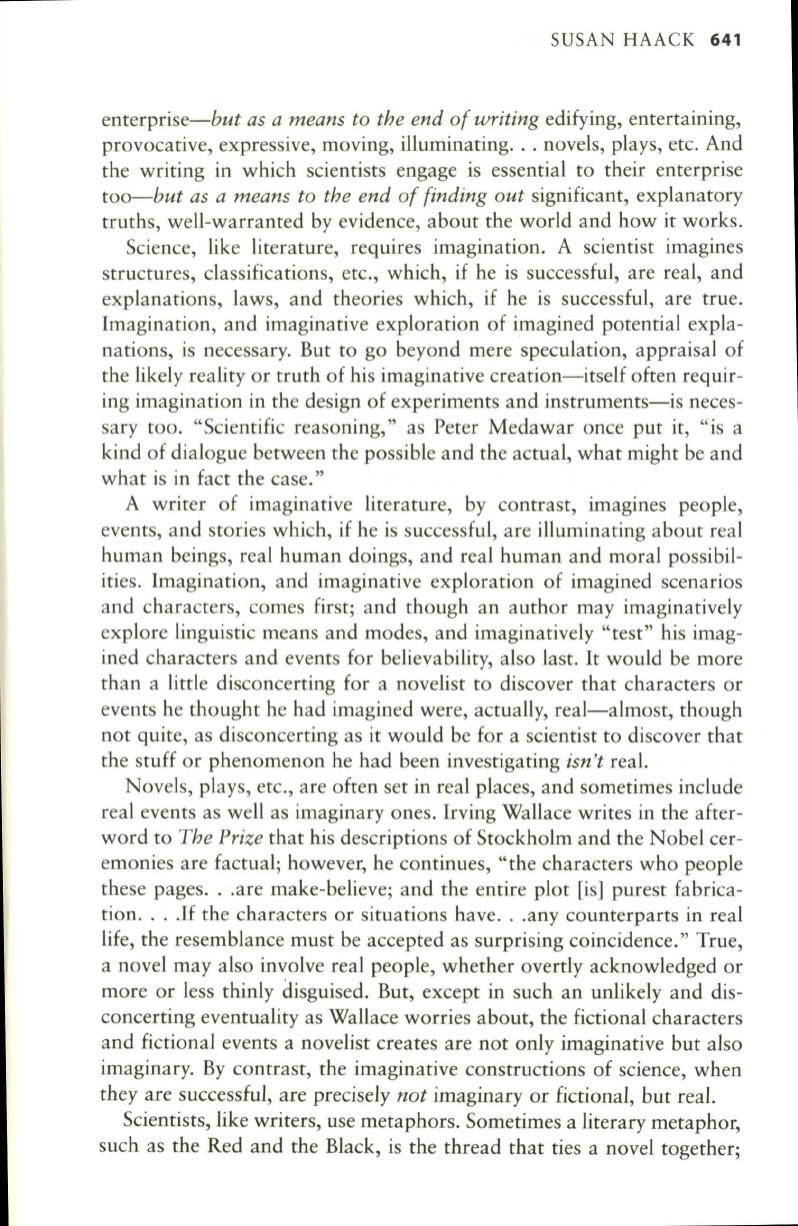
SUSAN HAACK
641
enterprise-but as a means to the end of writing
edifying, entertaining,
provocative, expressive, moving, illuminating... novels, plays, etc. And
the writing in which scientists engage is essential to their enterprise
too-but as a means to the end of finding out
significant, explanatory
truths, well-warranted by evidence, about the world and how it works.
Science, like literature, requires imagination. A scientist imagines
structures, classifications, etc., which, if he is successful, are real, and
explanations, laws, and theories which, if he is successful, are true.
Imagination, and imaginative exploration of imagined potential expla–
nations, is necessary. But to go beyond mere speculation, appraisal of
the likely reality or truth of his imaginative creation-itself often requir–
ing imagination in the design of experiments and instruments-is neces–
sary too. "Scientific reasoning," as Peter Medawar once put it, "is a
kind of dialogue between the possible and the actual, what might be and
what is in fact the case."
A writer of imaginative literature, by contrast, imagines people,
events, and stories which, if he is successful, are illuminating about real
human beings, real human doings, and real human and moral possibil–
ities. Imagination, and imaginative exploration of imagined scenarios
and characters, comes first; and though an author may imaginatively
explore linguistic means and modes, and imaginatively "test" his imag–
ined characters and events for believability, also last.
It
would be more
than a little disconcerting for a novelist to discover that characters or
events he thought he had imagined were, actually, real-almost, though
not quite, as disconcerting as it would be for a scientist to discover that
the stuff or phenomenon he had been investigating
isn't
real.
Novels, plays, etc., are often set in real places, and sometimes include
real events as well as imaginary ones. Irving Wallace writes in the after–
word to
The Prize
that his descriptions of Stockholm and the Nobel cer–
emonies are factual; however, he continues, "the characters who people
these pages...are make-believe; and the entire plot [is] purest fabrica–
tion....
If
the characters or situations have...any counterparts in real
life, the resemblance must be accepted as surprising coincidence." True,
a novel may also involve real people, whether overtly acknowledged or
more or less thinly disguised . But, except in such an unlikely and dis–
concerting eventuality as Wallace worries about, the fictional characters
and fictional events a novelist creates are not only imaginative but also
imaginary. By contrast, the imaginative constructions of science, when
they are successful, are precisely
not
imaginary or fictional, but real.
Scientists, like writers, use metaphors. Sometimes a literary metaphor,
such as the Red and the Black, is the thread that ties a novel together;


